Click On Image
For Full Size | Size |
Image Description |
Source |
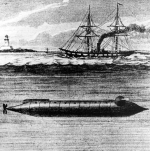 | 665k | The Alligator was the first submarine purchased by the U.S. Navy. It contained two crude air purifiers, a chemical based system for producing oxygen and a bellows to force air through lime. | Text & photo courtesy of chinfo.navy.mil. |
 | 158k | Villeroi's original, hand-drawn designs of the Alligator. | Photo courtesy of Historique de la Marine/National Oceanic and Atmospheric Administration & noaanews.noaa.gov. |
 | 38k | Exterior side view of the view of Villeroi's original, hand-drawn designs of the Alligator. | Photo courtesy of Historique de la Marine/National Oceanic and Atmospheric Administration & noaanews.noaa.gov. |
 | 62k | Interior side view of Villeroi's original, hand-drawn designs of the Alligator. | Photo courtesy of Historique de la Marine/National Oceanic and Atmospheric Administration & noaanews.noaa.gov. |
 | 70k | Interior top view of Villeroi's original, hand-drawn designs of the Alligator. | Photo courtesy of Historique de la Marine/National Oceanic and Atmospheric Administration & noaanews.noaa.gov. |
 | 69k | Exterior top view of the Alligator with cross section. | Photo courtesy of Historique de la Marine/National Oceanic and Atmospheric Administration & noaanews.noaa.gov. |
 | 266k | Alligator shown in what we believe was her actual configuration.
| Drawing by Jim Christley. |
 | 990k | Alligator plan, 1862. | Drawing by Jim Christley. |
|
 | 405k | The Launch.
This painting shows the boat being lowered into the water for the first time on 1 May 1862 in Philadelphia, PA. The original is in the collection of the Philadelphia Independence Seaport Museum Collection.
| Drawing by Jim Christley. |
|
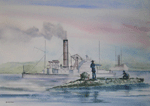 | 439k | Alligator in the James.
This shows the boat with the steam tug Satelite in the background in the James River in June of 1862 during the Seven Days Campaign. | Drawing by Jim Christley. |
|
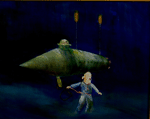 | 832k | Diver Deployed.
This is a painting in a private collection. The boat’s primary weapon, a tethered hard hat diver is making his way along the bottom after having exited from the lock out chamber.
| Photo courtesy of Jim Christley. |
|
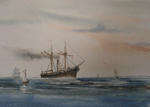 | 720k | Sumpter setting out with Alligator in tow.
| Drawing by Jim Christley. |
|
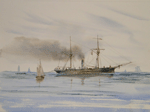 | 831k | Sumpter with Alligator Under Tow.
The original is in a private collection. | Photo courtesy of Jim Christley. |
|
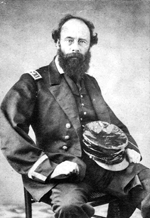 | 146k | Acting Master Samuel Eakins served as the 2nd commanding officer of the first Union Navy's submarine Alligator. He had a very short career in the Union Navy having been the “civilian overseer” during the Alligator's glorious puttering around in Navy experiments. He was appointed Acting Master on 24 March 1863 and had his appointment was revoked on 15 April 1863 shortly after the Alligator was "lost at sea" on 2 April 1863. | USN photo courtesty of Bill Gonyo. |
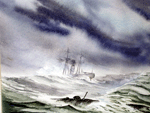 | 756k | Demise of Alligator.
This painting is a part of the Office of Naval Research collection and shows the boat after being cut loose in a storm off Cape Hatteras.
| Drawing by Jim Christley. |
|
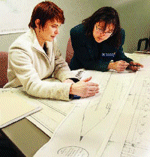 | 25k | Catherine Marzin, left, and Michiko Martin examine Brutus De Villeroi's design drawings of the Alligator that Marzin found last year in France. Both women work for the National Marine Sanctuaries Program and are members of the Alligator Project team. | Photo courtesty of (NOAA)/ newbernsj.com The New Bern Sun Journal. |
 | 339k | Visitors to the Preservation Society in Ocracoke, N.C., view a display featuring the U.S. Navy's first submarine, Alligator invented by Brutus de Villeroi, and built in Philadelphia in 1862. | USN photo # N-7676W-025 by Chief Journalist John F. Williams, courtesty of news.navy.mil. |
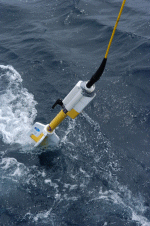 | 425k | The Geometrics G-882 Magnetometer is one of the main survey tools being used in a high-tech underwater search by the National Oceanic and Atmospheric Administration (NOAA), with support from the Office of Naval Research (ONR). The G-882 will be used during the hunt for the Navy's first submarine, the Alligator in a week-long expedition in an area off Cape Hatteras where the Civil War era vessel was lost during a fierce storm in 1863. | USN photo # N-7676W-074 by Chief Journalist John F. Williams, courtesty of news.navy.mil. |
 | 332k | Chief Scientist, National Oceanic and Atmospheric Administration (NOAA) Mike Overfield, adjusts the display receiving data from the Towfish. The Towfish is a 600KHZ Marine Sonic Side Scan Sonar unit that is being used during by National Oceanic and Atmospheric Administration (NOAA), with support from the Office of Naval Research (ONR) are conducting search for the Navy's first submarine, the Alligator. | USN photo # N-7676W-133 by Chief Journalist John F. Williams, courtesty of news.navy.mil. |
 | 391k | The Office of Naval Research (ONR) vessel YP-679, Afloat Lab, was open for visitation while docked in Ocracoke, N.C., 24 August 2004, where it is taking part in the 2004 Hunt for the Alligator Expedition. The National Oceanic and Atmospheric Administration (NOAA), with support from ONR is conducting a week-long expedition off Cape Hatteras where the Civil War era vessel was lost during a fierce storm in 1863. | USN photo # N-7676W-041 by Chief Journalist John F. Williams, courtesty of news.navy.mil. |
 | 411k | Chief Scientist, National Oceanic and Atmospheric Administration (NOAA) Mike Overfield, discusses the day's plans with the crew prior to departing Cracker, N.C. NOAA with support from the Office of Naval Research (ONR) while conducting a search for the Navy's first submarine the, Alligator. | USN photo # N-7676W-022 by Chief Journalist John F. Williams, courtesty of news.navy.mil. |
 | 358k | East Carolina University maritime studies graduate student Chris McCabe, attaches a cable to the Towfish. The Towfish is a 600KHZ Marine Sonic Side Scan Sonar unit that is being used by National Oceanic and Atmospheric Administration (NOAA), with support from the Office of Naval Research (ONR) while conducting search for the Navy's first submarine the Alligator. | USN photo # N-7676W-018 by Chief Journalist John F. Williams, courtesty of news.navy.mil. |
 | 332k | The Geometrics G-882 Magnetometer is one of the main survey tools being used in a high-tech underwater search for the Navy's first submarine the Alligator. | USN photo # N-7676W-012 by Chief Journalist John F. Williams, courtesty of news.navy.mil. |
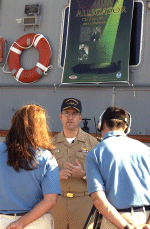 | 224k | Education Liaison, Kate Thompson, left, and Media Coordinator, David Hall assigned to the National Oceanic and Atmospheric Administration (NOAA) interview Deputy, Commander Submarine Force Atlantic, Rear Adm. Jay Deloach, center, for an education video that will be used as part of the 2004 Hunt for the Alligator Expedition video. | USN photo # N-7676W-073 by Chief Journalist John F. Williams, courtesty of news.navy.mil. |
 | 332k | Chief Scientist, National Oceanic and Atmospheric Administration (NOAA) Mike Overfield, adjusts the display receiving data from the Towfish. The Towfish is a 600KHZ Marine Sonic Side Scan Sonar unit that is being used during by National Oceanic and Atmospheric Administration (NOAA), with support from the Office of Naval Research (ONR) are conducting search for the Navy's first submarine the Alligator. | USN photo # N-7676W-044 by Chief Journalist John F. Williams, courtesty of news.navy.mil. |
 | 413k | Mark Connelly, left, and Gary Umberger, center, both with Naval Sea Systems Command (NAVSEA), work with a crew man to retrieve the Office of Naval Research (ONR) funded Remote Environmental Monitoring UnitS (REMUS) off the coast of Cape Hatteras, N.C., after conducting a search for the Alligator. Based in Ocracoke, N.C., the 2005 survey is part of an ongoing effort by National Oceanographic and Atmospheric Administration (NOAA), ONR, and partners to solve the mystery of the Alligator's fate while promoting scientific and historical research, education and ocean literacy, 9 September 2005. | USN photo # N-7676W-054 by Chief Journalist John F. Williams, courtesty of news.navy.mil. |
 | 250k | Aamir Qaiyumi, foreground, and Mark Connelly, with Naval Sea Systems Command (NAVSEA) in Panama City, Fla., 10 September 2005, analyze data from Remote Environmental Monitoring Units (REMUS) aboard the Office of Naval Research (ONR) vessel, YP-679. The side scan sonar data was collected from the autonomous underwater vehicle (AUV) during the previous days mission when the National Oceanographic and Atmospheric Administration (NOAA), with support from ONR, returned to the "Graveyard of the Atlantic" to continue the search for the Alligator, the U.S. Navy's first submarine. | USN photo # N-7676W-063 by Chief Journalist John F. Williams, courtesty of news.navy.mil. |
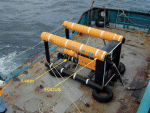 | 84k | The Laser Line Scan instrument, mounted on the FOCUS 1500 Remote Operated Tow Vehicle (ROTV). | Image courtesy of Scientific Applications International Corporation, courtesy of oceanexplorer.noaa.gov. |
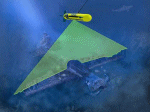 | 43k | The laser line scan (LLS) systems utilize a sweeping blue-green laser to reflect light across the seafloor to generate a gray-scale image similar to a black and white photography.
| Image courtesy of Scientific Applications International Corporation, courtesy of oceanexplorer.noaa.gov. |
 | 294k | Dreams of Discovery.
This also is in a private collection. It shows the boat on the bottom, possibly off Cape Hatteras in 10,000 feet of water being surveyed after discovery by an AUV. The boat has not been discovered and it most likely will never be. | Photo courtesy of Jim Christley. |
|
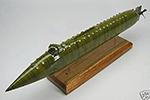 | 139k | Model Alligator. |
Photo courtesy of Tommy Trampp.
|